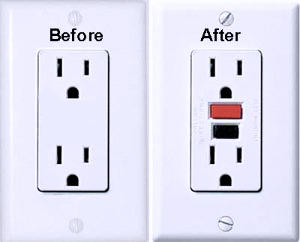When electrical outlets are installed,  it is not a random choice as to where they are placed or what type of outlet to use. Electricians and builders must adhere to strict building codes under the National Electrical Code as published by the U.S. National Fire Protection Association, designed to provide safe usage.
it is not a random choice as to where they are placed or what type of outlet to use. Electricians and builders must adhere to strict building codes under the National Electrical Code as published by the U.S. National Fire Protection Association, designed to provide safe usage.
Kitchen Outlets
The electrical code is based on logic. For example, in a kitchen, the countertop outlets (or receptacles) should be placed no more than 48 inches from each other, giving the homeowner 24 inches from the outlet to any point on the countertop, which is the average cord length of most kitchen appliances. Outlets should also be no more than 20” above the countertops. This helps avoid a homeowner from having to stretch a cord to reach an outlet and creating a dangerous situation. Only GFCI (ground fault current interrupter) outlets can be installed, and no outlet can be face up.
Bathroom and Laundry Outlets
Since bathrooms and laundry rooms contain water sources, they also require only GFCI outlets. If triggered, these circuit interrupters will trip and open the circuit, cutting of the electrical current to prevent electrocution. They are equipped with both a test button and a reset button, and it is recommended to test them monthly.
Interior Wall Outlets
The Code requires that a wall outlet be placed every 12 feet on an interior wall, which prevents an electrical cord having to be stretched more than 6 feet to reach one. However, with the proliferation of electronic devices, many homeowners are opting to install additional wall outlets. The only exception to this requirement is if a wall is less than 24 inches wide.
Depending on the amperage carried by the outlet, either at 15A or a 20A tamper-resistant outlet should be installed. The circuit breaker will indicate which is required. As an additional safety measure, the tamper-resistant outlets are more often being required. They feature a spring-loaded gate within the outlet that is too strong for young children to open, as for example, with a knife or other flat object. Look for the letters “TR” (for Tamper Resistant) on the outlet’s face.
Exterior Wall Outlets
Because outdoor electrical outlets are exposed to weather elements like water, it is important that all 15-amp, 20-amp and 120-volt outlets be GFCI-protected either with a GFCI receptacle or a GFCI breaker.
All outlets being installed in wet or damp locations must also be Weather Resistant (WR) and Tamper Resistant (TR), have gasket-lined weatherproof covers to seat the unit from moisture, and have a weatherproof cover to protect the receptacle when a cord is plugged in, but not in use.
See an example of a “wrong” exterior outlet on our Gallery page.
Height requirements also apply. Outlets required at the front and back door, and those within a deck, balcony or porch larger than 20 square feet should be mounted no higher than 6’ 6” above grade.
Notice an Outlet Problem? Contact Först.
This is only a brief overview of the types of outlets required by construction codes. If you notice your outlets do not meet codes or are not working properly and you live in Northern Virginia, one action is to call Först Consulting Group in to check them. We’ll be glad to perform an inspection of your interior and exterior electrical outlets.
Protecting yourself against electrical fires, accidents and electrocution is important to your family’s safety. Contact Först today for a complete inspection.




